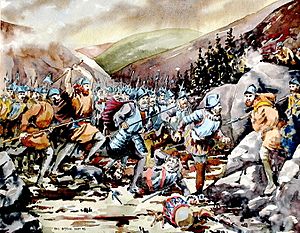Battle of Glenmalure facts for kids
Quick facts for kids Battle of Glenmalure |
|||||||
|---|---|---|---|---|---|---|---|
| Part of the Second Desmond Rebellion | |||||||
 |
|||||||
|
|||||||
| Belligerents | |||||||
| Irish of Wicklow, Old English rebels |
|||||||
| Commanders and leaders | |||||||
| Fiach Mac Aodh Ó Broin, James Eustace, 3rd Viscount Baltinglass |
Arthur Grey, 14th Baron Grey de Wilton, Colonel George Moore |
||||||
| Strength | |||||||
| 700 | >2,000 | ||||||
| Casualties and losses | |||||||
| Low | 31 killed (100 at most) | ||||||
The Battle of Glenmalure (Irish: Cath Ghleann Molúra) was an important fight in Ireland on 25 August 1580. It happened during the Desmond Rebellions, which were a series of conflicts between some Irish lords and the English government.
In this battle, a group of Irish clans from the Wicklow Mountains joined forces with some Old English rebels. They were led by Fiach MacHugh O'Byrne and James Eustace, 3rd Viscount Baltinglass. They fought against a large English army led by Arthur Grey, 14th Baron Grey de Wilton. The battle took place in Glenmalure, a strong mountain area belonging to the O'Byrne family. The Irish forces won this battle.
What Led to the Battle?
Lord Grey arrived in Ireland in August 1580 with many new soldiers from England. His army had over 2,000 men. This was the biggest English army sent to Ireland in many years. Such a large force made many people think twice about joining the rebels.
Lord Grey was not very experienced in fighting in Ireland's tough landscape. He had also been out of military service for two decades. He didn't know much about how to govern Ireland, even though he was the new Lord Deputy. His main goal was simply to defeat the rebels.
Fiach MacHugh O'Byrne and Lord Baltinglass, along with their allies from the O'Toole family, decided to pull back. They moved their forces into the mountains of Glenmalure. From there, they sent a message to Lord Grey asking for protection. However, Grey had strict orders not to offer any pardons. He saw their message as a sign of their arrogance.
On August 18, Lord Grey moved his army to Naas. He gathered guides and planned his attack. He wanted to march around the Wicklow Mountains to surprise O'Byrne's forces from the south-east. But the rebels were hard to find. Grey's army marched deeper into the mountains. The land became very difficult, forcing his men into a narrow valley. O'Byrne soon learned about the English army's movements. This was partly due to people leaving Grey's allies and also because the English soldiers wore bright red and blue coats, making them easy to spot.
The Battle Begins
The English army saw what looked like the first group of Irish rebels. Lord Grey ordered his soldiers to attack right away. Some of his more experienced allies from Kildare advised against this. They, along with Grey's cavalry, stayed on a nearby hill. They did not take part in the main fight.
The English front group, led by Colonel George Moore, chased the Irish rebels into the glen. A glen is a narrow valley. This one was about four miles long with a river running through it. It had very steep sides and was covered in thick trees and plants, reaching up to 2,000 feet high.
The English soldiers fought the Irish as they were pulled deeper into the glen. The ground became very bad, with rocks, muddy bogs, and thick woods. Colonel Moore tried to move his troops higher up the northern slope. He might have wanted better ground, or he might have thought his soldiers were in danger of an ambush.
While climbing the steep slopes, the English soldiers were ambushed. The Irish fighters were hidden in the woods. They shot at the English for a long time. The English soldiers, who were not used to this kind of fighting, lost their order and ran back down the valley. Most of their losses happened at this point. The Irish left their hiding places and attacked the fleeing English with swords, spears, and axes. Many English soldiers were killed as they tried to escape.
The remaining English soldiers had to fight their way back for several miles. They finally reached the town of Rathdrum. Lord Grey's cavalry and his rear guard helped prevent the English forces from being completely destroyed.
What Happened After
Irish records say that about 800 English soldiers died. However, English records state their losses were six officers and twenty-five soldiers. It's possible the English records didn't count their Irish allies who died. But the total number of deaths was probably not more than 100.
One of the people killed was Peter Carew. He was a cousin of another Peter Carew who had claimed and won large areas of land in southern Ireland. The rest of the English army went back to the lowlands of Wicklow and then to Dublin.
However, the next year, most of the Irish soldiers, including O'Byrne, surrendered when offered terms. Lord Baltinglass was an exception; he escaped to France.
See also
- Irish battles
- History of Ireland

